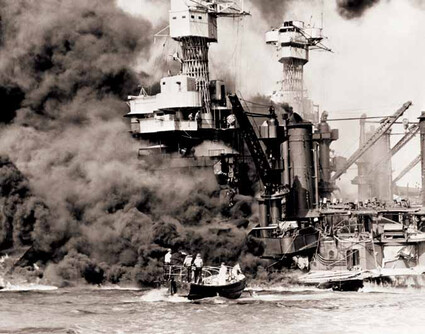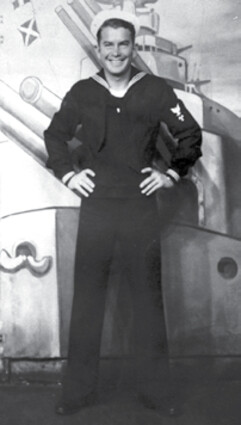Pearl Harbor Day Remembered
Last updated 12/5/2023 at 8:41pm

The USS West Virginia (BB-48) was moored on "Battleship Row" when the Japanese attacked Pearl Harbor. The West Virginia was struck by up to nine enemy torpedoes, tearing open her midships and forward hull and wrecking her rudder.
President Franklin D. Roosevelt declared December 7th as "a date which will live in infamy" after Japanese airplanes bombed an American naval base Pearl Harbor killing U.S. personnel.
As a result, on Aug. 23, 1994, United States Congress, designated Dec. 7 of each year as National Pearl Harbor Remembrance Day. It is a tradition to fly the Flag of the United States at half-staff until sunset in honor of dead patriots.
This week marks 82 years since the history changing day occurred .
The day began like many before it with a few exceptions. At approximately 6 a.m., 183 Japanese planes took off from six aircraft carriers 230 miles north of Oahu. This was just the first wave that would hit Pearl Harbor. At 7:02 a.m., two Army operators at a radar station on Oahu's northern shore detected the fleet of planes approaching. It was disregarded because several American B-17 planes were expected to come in from the U.S. west coast.
A short time later, at 7:15 a.m. 167 more Japanese planes took off and headed for Pearl Harbor. This was the second wave. The naval base was not put on high alert because the senior commanders felt there was no reason to believe an attack was imminent.
Aircraft were parked wing tip to wing tip. Anti-aircraft guns remained unmanned and ammunition locked up. Also, there were not any torpedo nets protecting the fleet anchorage. Given that it was a Sunday, many officers and crewman were ashore.
At 7:53 a.m., the first wave of Japanese planes reached Pearl Harbor and the battle began.
"It took us a while to wake up to what was really going on," said Joseph Rougeau who recalled the historic event before his death in May 2012. He was a Navy Seaman 1st Class and aboard the USS Medusa which was a fleet repair ship and docked at Pearl Harbor. Rougeau was eating breakfast when the attack started.
The first wave targeted airfields and battleships. The second targets were ships and shipyard facilities. Japan modified their shells to use them as bombs and wooden fins were added to torpedoes to keep them from sinking in the shallow harbor mud.
The air raid lasted until 9:45 a.m.
McKinnley Bland, of Orange, joined the United States Navy in 1939 at the age of 21 and served for 21 years. Bland passed away in 2017, but not before sharing his story of the attack on Pearl Harbor.
Bland started out as a seaman and retired as Chief Petty Officer. He was assigned to the USS Salt Lake City as a steward.
He was up on deck cooking and serving food to the officers. He could see what was going on outside the ship when the Japanese bombers started bombing Pearl Harbor. He witnessed the attack on the USS Arizona.
The Arizona sustained the most damage in the raid. The ship took four direct hits from Japanese bombers. The last bomb ignited a forward magazine causing a devastating explosion. The ship sank claiming 1,177 lives. It remains in the harbor to this day and serves as memorial to those who lost their lives.
"Some of the men were already lying on the deck already killed," he said. "I'm just a country boy. I ain't never seen nobody killed."
Once the bombing commenced, the Salt Lake City sailed out to sea and stayed there for 110 days. After the 110 days, the Salt Like City was allowed to come back in to Pearl Harbor to restock their supplies, according to archives.
It was a very surreal moment for Rougeau. The normal berth place was along side Fort Island. On Friday, the USS Medusa had to move to allow the USS Utah to have their preferred spot. Had the Utah not been docked there, the Medusa would have probably taken the hit. The Utah was hit by a torpedo at approximately 8:01 a.m. and capsized.
"You could see the smoke and oil on the water on fire." Rougeau said in a previous interview.
Sailors were trying to swim on top of the water even though they had been taught to swim under the water, come up for short breaths and go back under.
"Some were just out of boot camp or panicked, they were just swimming on top sucking in smoke and fire into their lungs," Rougeau said.
Rougeau went on to explain they couldn't send life boats down to the sailors because the boats were made of wood.
The normal berth place was along side Fort Island. Just days before, the USS Medusa had to move to allow the USS Utah to have their preferred spot. Had the Utah not been docked there, the Medusa would have probably taken the hit. The Utah was hit by a torpedo at approximately 8:01 a.m. and capsized.
Cedric Stout, of Bridge City, was assigned to the Utah at the time of the attack. Stout was killing time looking out the porthole after breakfast.
"I saw all the commotion going on and thought, somebody's having some fun. But then a bullet went phew, right over the top of my head and I knew it wasn't no fun!" he said in a previous interview. "Almost immediately, torpedoes struck the port side of the ship and the superior officers were telling everyone to abandon ship, so I made it topside as quickly as possible."
At the hatch, Stout saw his shipmates being cut down as soon as they got up there, so Stout said he decided to hold back.
"When it became apparent that the Utah was going to roll over, we decided our chances were better dodging bullets than staying aboard to drown," Stout said." We ran to the ropes that held the Utah at dock, slid down to the mooring, made our way to the island and scrambled for cover."
A sailor who had run in the other direction became trapped in the ship's bough when it overturned. He had a metal pipe he would hit against the ship to let people know he was there. He did that for seven days before being found when someone heard the banging. A hole was cut out of the hull to set him free, dehydrated, but alive, according to Stout.
Fifty four sailors remain entombed in the USS Utah, according to archives.
Eight battle ships are damaged and two of them sunk. Three light cruisers, three destroyers and three smaller vessels are lost along with 188 aircraft. The USS Arizona and the USS Utah were left where they sank and stand as memorials so that all will remember the fate of the crew that were claimed by the sea. The Arizona continues to leak oil from it's hull and it is theorized that when the last living survivor from the Arizona dies, the oil will stop leaking.
The USS Oklahoma was damaged beyond repair. The ship took five torpedoes and capsized. Four hundred and twenty nine sailors were lost or are missing. The ship was pulled from the sea but never repaired.
The Oklahoma was striped of her weapons and sold for scrap. In 1947, the Oklahoma sank in mid-tow 540 miles out from Pearl Harbor, according to archives.
The USS Arizona memorial in Pearl Harbor is a marble memorial over the sunken battleship USS Arizona, which was dedicated in 1962. The memorial remembers all military personnel who were killed in the Pearl Harbor attack. Another memorial is of the USS Utah. The battleship was attacked and sunk. A memorial to honor the crew of the USS Utah was dedicated on the northwest shore of Ford Island, near the ship's wreck, in 1972. The ship was added to the National Register of Historic Places and declared a National Historic Landmark in 1989.
The United States lost 2,390 lives that day: 1,999 from the Navy, 109 from the Marine Corps, 233 from the Army and Army Air Force and 49 civilians.
During the time Bland and the rest of the crew on the Salt Lake City spent out at sea, the ship joined forces with a fleet of ships that escorted the Doolittle Raid mission. On April 18, 1942, 16 B-25 bombers were launched from the USS Hornet and the Doolittle Raid was the first attack on Japan during World War II.
"We escorted [the Hornet] into Japanese water," Bland said. "It was kind of amusing to see all of these planes on deck, but after a while, they started taking off."
Bland explained that the planes were only a few inches from the water when the plane left the deck of the Hornet, but the pilots managed to keeps those planes in the air.
Bland received the Purple Heart due to a battle wound sustained during a skirmish with a Japanese battle cruiser near Guadalcanal.
Upon his return home, Bland worked for the postal service for more than 20 years.
Rougeau was eventually transferred to a different ship that transported the Marine Corps to the invasion of Iwo Jima and Okinawa. Rougeau did not re-enlist when his tour was up, but he couldn't leave due to the war.

Young Cedric Stout
"When the war was over, it didn't take me long to get home," Rougeau said. He then spent 36 years working for Parish Electric. Even though he was technically retired, he still worked part time with the company.
Cutlines:
The USS West Virginia (BB-48) was moored on "Battleship Row" when the Japanese attacked Pearl Harbor. The West Virginia was struck by up to nine enemy torpedoes, tearing open her midships and forward hull and wrecking her rudder.
The USS West Virginia (BB-48) was moored on "Battleship Row" when the Japanese attacked Pearl Harbor. The West Virginia was struck by up to nine enemy torpedoes, tearing open her midships and forward hull and wrecking her rudder.














Reader Comments(0)